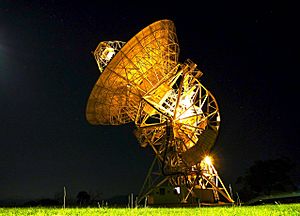Mount Pleasant Radio Observatory facts for kids
| Location | Cambridge, Tasmania, Australia |
|---|
The Mount Pleasant Radio Observatory is a special place where scientists study space using radio waves. It's like a giant ear listening to the universe! This observatory is owned by the University of Tasmania. You can find it about 20 kilometers east of Hobart in Cambridge, Tasmania. It has several large antennas that act as telescopes and a museum.
Contents
What is a Radio Observatory?
A radio observatory uses special antennas, called radio telescopes, to "see" things in space. Unlike regular telescopes that use light, radio telescopes pick up radio waves. These waves come from stars, galaxies, and other objects far away. By studying these waves, scientists learn about the universe.
Amazing Equipment at Mount Pleasant
The Mount Pleasant Radio Observatory has powerful tools to explore space.
Active Radio Telescopes
The observatory uses two main radio telescopes right now. One is a large 26-meter antenna. The other is a 12-meter AuScope VLBI Antenna. These antennas work together to collect signals from space.
Connecting to the University
The observatory is connected to the University of Tasmania's main campus in Hobart. A 25-kilometer fibre optic cable links them. This cable was put in place in 2007. It helps send all the information collected by the telescopes very quickly.
The 26-Meter Radio Dish
The big 26-meter radio dish has an interesting history. It used to be at the Orroral Valley Tracking Station. There, it helped track satellites. It even supported NASA missions with astronauts. Now, this dish is part of Australia's very long baseline interferometry (VLBI) network. VLBI is a way to link many telescopes together. This makes them act like one giant telescope.
The Vela Telescope
The observatory also had a 14-meter Vela telescope. It was built in 1981. This telescope was made to watch a special star called the Vela Pulsar. It tracked this pulsar for about 18 hours every day. This went on for more than 20 years! The Vela telescope stopped working in 2006.
Other Telescopes Operated by the University
The University of Tasmania also runs other radio telescopes in Australia.
- A 30-meter radio observatory in Ceduna, South Australia.
- Two more 12-meter AuScope antennas. One is in Katherine, Northern Territory. The other is in Yaragadee, Western Australia.
The University also owns the Bisdee Tier Optical Astronomy Observatory. This observatory uses light, not radio waves, to study space. Another observatory, the Canopus Hill Observatory, is now closed.
The Grote Reber Museum
There's a museum right at the observatory! It's all about a famous scientist named Grote Reber. He was a pioneer in radio astronomy. The museum tells his life story and shows his work. It even has some of his ashes. You can also watch a 3D movie there. The museum explains how Tasmania has played a big part in the science of radiophysics. About 5,000 people visit the museum each year. It also has special Open Days. Some university students help as tour guides.
See also
- List of radio telescopes


